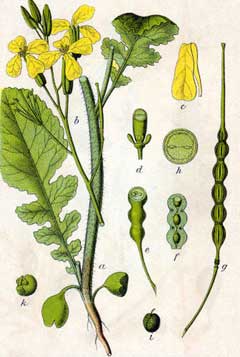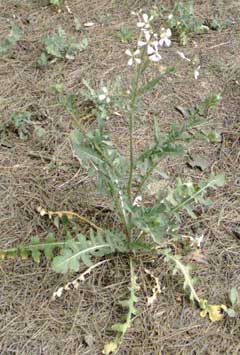 |
|
http://commons.wikimedia.org/wiki/File:Raphanus_raphanistrum_Sturm40.jpg |
 |
| http://es.wikipedia.org/wiki/Usuario:Alberto_Salguero |
Translate this page:
Summary
Physical Characteristics

 Raphanus raphanistrum is a ANNUAL growing to 1.2 m (4ft).
Raphanus raphanistrum is a ANNUAL growing to 1.2 m (4ft).
It is not frost tender. The species is hermaphrodite (has both male and female organs) and is pollinated by Bees, flies.
Suitable for: light (sandy), medium (loamy) and heavy (clay) soils. Suitable pH: mildly acid, neutral and basic (mildly alkaline) soils. It can grow in semi-shade (light woodland) or no shade. It prefers moist soil.
UK Hardiness Map
US Hardiness Map
Synonyms
Plant Habitats
Cultivated Beds;
Edible Uses
Edible Parts: Flowers Leaves Oil Seed Seedpod
Edible Uses: Condiment Oil
Young leaves - raw or cooked[2, 105]. A somewhat hot taste, they are finely cut and added to salads or used as a potherb[183]. It is best to use just the young leaves in spring, older leaves soon become bitter[9]. Seed - raw or cooked. A very pungent flavour, the seed can be ground into a powder and made into a paste when it is an excellent substitute for mustard[2, 9, 115, 183]. The sprouted seeds have a somewhat hot spicy flavour and are a tasty addition to salads[183]. Flowers - raw. A nice addition to salads. The flower buds are used as a broccoli substitute, they should be lightly steamed for no more than 5 minutes[9]. Young seedpods - raw. Crisp and juicy, they must be eaten when young because they quickly become tough and fibrous[K]. An edible oil is obtained from the seed[115].
References More on Edible Uses
Medicinal Uses
Plants For A Future can not take any responsibility for any adverse effects from the use of plants. Always seek advice from a professional before using a plant medicinally.
Antirheumatic
Antirheumatic[13].
References More on Medicinal Uses
The Bookshop: Edible Plant Books
Our Latest books on Perennial Plants For Food Forests and Permaculture Gardens in paperback or digital formats.

Edible Tropical Plants
Food Forest Plants for Hotter Conditions: 250+ Plants For Tropical Food Forests & Permaculture Gardens.
More

Edible Temperate Plants
Plants for Your Food Forest: 500 Plants for Temperate Food Forests & Permaculture Gardens.
More

More Books
PFAF have eight books available in paperback and digital formats. Browse the shop for more information.
Shop Now
Other Uses
Oil
None known
Special Uses
References More on Other Uses
Cultivation details
Prefers a rich soil with ample moisture[16, 52]. Dislikes very heavy soils[37]. This plant is a host of an eelworm that attacks cultivated crops[13]. This species is possibly the original source of the cultivated radish, R. sativus[46]. The flowers are very attractive to bees[108].
References Carbon Farming Information and Carbon Sequestration Information
Temperature Converter
Type a value in the Celsius field to convert the value to Fahrenheit:
Fahrenheit:
The PFAF Bookshop
Plants For A Future have a number of books available in paperback and digital form. Book titles include Edible Plants, Edible Perennials, Edible Trees,Edible Shrubs, Woodland Gardening, and Temperate Food Forest Plants. Our new book is Food Forest Plants For Hotter Conditions (Tropical and Sub-Tropical).
Shop Now
Plant Propagation
Seed - sow spring in situ. Germination should take place within 2 weeks.
Other Names
If available other names are mentioned here
Native Range
TEMPERATE ASIA: Cyprus, Iran, Iraq, Israel, Jordan, Lebanon, Syria, Turkey, Russian Federation-Ciscaucasia (Ciscaucasia), Armenia, Azerbaijan, Georgia EUROPE: Denmark, Finland, United Kingdom, Ireland, Norway, Sweden, Austria, Belgium, Switzerland, Czech Republic, Germany, Hungary, Netherlands, Poland, Slovakia, Russian Federation (European part), Belarus, Estonia, Lithuania, Latvia, Moldova, Ukraine (incl. Krym), Albania, Bulgaria, Bosnia and Herzegovina, Greece (incl. Crete), Croatia, Italy (incl. Sardinia, Sicily), North Macedonia, Montenegro, Romania, Serbia, Slovenia, Spain (incl. Baleares), France (incl. Corsica), Portugal AFRICA: Spain (Canarias), Portugal (Madeira Islands), Algeria (north), Egypt (north), Libya (north), Morocco, Tunisia
Weed Potential
Right plant wrong place. We are currently updating this section.
Please note that a plant may be invasive in one area but may not in your area so it's worth checking.
Conservation Status
IUCN Red List of Threatened Plants Status :

Growth: S = slow M = medium F = fast. Soil: L = light (sandy) M = medium H = heavy (clay). pH: A = acid N = neutral B = basic (alkaline). Shade: F = full shade S = semi-shade N = no shade. Moisture: D = dry M = Moist We = wet Wa = water.
Now available:
Food Forest Plants for Mediterranean Conditions
350+ Perennial Plants For Mediterranean and Drier Food Forests and Permaculture Gardens.
[Paperback and eBook]
This is the third in Plants For A Future's series of plant guides for food forests tailored to
specific climate zones. Following volumes on temperate and tropical ecosystems, this book focuses
on species suited to Mediterranean conditions—regions with hot, dry summers and cool, wet winters,
often facing the added challenge of climate change.
Read More
Expert comment
Author
L.
Botanical References
17
Links / References
For a list of references used on this page please go here
Readers comment